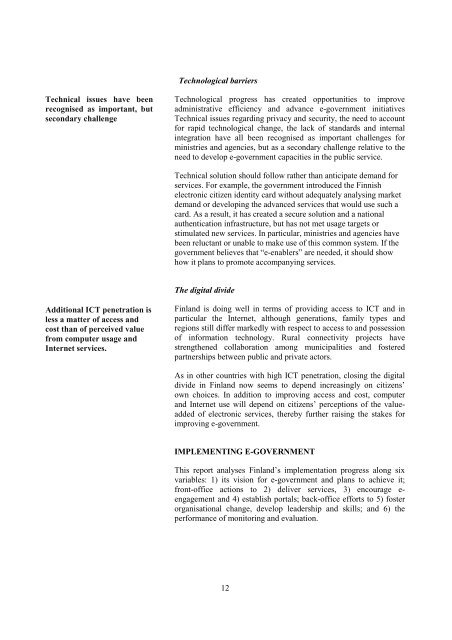e-GOVERNMENT IN FINLAND - ePractice.eu
e-GOVERNMENT IN FINLAND - ePractice.eu
e-GOVERNMENT IN FINLAND - ePractice.eu
Create successful ePaper yourself
Turn your PDF publications into a flip-book with our unique Google optimized e-Paper software.
Technical issues have been<br />
recognised as important, but<br />
secondary challenge<br />
Additional ICT penetration is<br />
less a matter of access and<br />
cost than of perceived value<br />
from computer usage and<br />
Internet services.<br />
Technological barriers<br />
Technological progress has created opportunities to improve<br />
administrative efficiency and advance e-government initiatives<br />
Technical issues regarding privacy and security, the need to account<br />
for rapid technological change, the lack of standards and internal<br />
integration have all been recognised as important challenges for<br />
ministries and agencies, but as a secondary challenge relative to the<br />
need to develop e-government capacities in the public service.<br />
Technical solution should follow rather than anticipate demand for<br />
services. For example, the government introduced the Finnish<br />
electronic citizen identity card without adequately analysing market<br />
demand or developing the advanced services that would use such a<br />
card. As a result, it has created a secure solution and a national<br />
authentication infrastructure, but has not met usage targets or<br />
stimulated new services. In particular, ministries and agencies have<br />
been reluctant or unable to make use of this common system. If the<br />
government believes that “e-enablers” are needed, it should show<br />
how it plans to promote accompanying services.<br />
The digital divide<br />
Finland is doing well in terms of providing access to ICT and in<br />
particular the Internet, although generations, family types and<br />
regions still differ markedly with respect to access to and possession<br />
of information technology. Rural connectivity projects have<br />
strengthened collaboration among municipalities and fostered<br />
partnerships between public and private actors.<br />
As in other countries with high ICT penetration, closing the digital<br />
divide in Finland now seems to depend increasingly on citizens’<br />
own choices. In addition to improving access and cost, computer<br />
and Internet use will depend on citizens’ perceptions of the valueadded<br />
of electronic services, thereby further raising the stakes for<br />
improving e-government.<br />
IMPLEMENT<strong>IN</strong>G E-<strong>GOVERNMENT</strong><br />
This report analyses Finland’s implementation progress along six<br />
variables: 1) its vision for e-government and plans to achieve it;<br />
front-office actions to 2) deliver services, 3) encourage eengagement<br />
and 4) establish portals; back-office efforts to 5) foster<br />
organisational change, develop leadership and skills; and 6) the<br />
performance of monitoring and evaluation.<br />
12
















